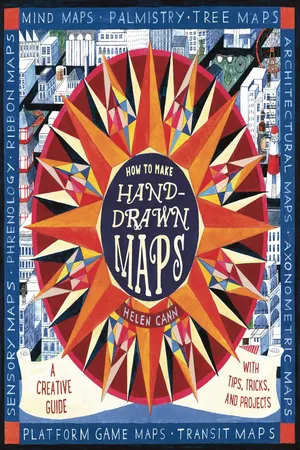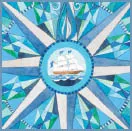
- 192 pages
- English
- ePUB (mobile friendly)
- Available on iOS & Android
eBook - ePub
About this book
With wonderful examples and easy-to-follow instructions, this beautifully illustrated how-to book makes it simple and fun to create one-of-a-kind hand-drawn maps. Helpful templates, grids, and guidelines complement a detailed breakdown of essential cartographic elements and profiles of talented international map artists. From city maps and family trees to treasure maps, palmistry charts, platformgame maps, and more, the wide range of projects collected here will satisfy first-time cartographers as well as veteran mapmakers inspired by the popular map art trend.
Frequently asked questions
Yes, you can cancel anytime from the Subscription tab in your account settings on the Perlego website. Your subscription will stay active until the end of your current billing period. Learn how to cancel your subscription.
At the moment all of our mobile-responsive ePub books are available to download via the app. Most of our PDFs are also available to download and we're working on making the final remaining ones downloadable now. Learn more here.
Perlego offers two plans: Essential and Complete
- Essential is ideal for learners and professionals who enjoy exploring a wide range of subjects. Access the Essential Library with 800,000+ trusted titles and best-sellers across business, personal growth, and the humanities. Includes unlimited reading time and Standard Read Aloud voice.
- Complete: Perfect for advanced learners and researchers needing full, unrestricted access. Unlock 1.4M+ books across hundreds of subjects, including academic and specialized titles. The Complete Plan also includes advanced features like Premium Read Aloud and Research Assistant.
We are an online textbook subscription service, where you can get access to an entire online library for less than the price of a single book per month. With over 1 million books across 1000+ topics, we’ve got you covered! Learn more here.
Look out for the read-aloud symbol on your next book to see if you can listen to it. The read-aloud tool reads text aloud for you, highlighting the text as it is being read. You can pause it, speed it up and slow it down. Learn more here.
Yes! You can use the Perlego app on both iOS or Android devices to read anytime, anywhere — even offline. Perfect for commutes or when you’re on the go.
Please note we cannot support devices running on iOS 13 and Android 7 or earlier. Learn more about using the app.
Please note we cannot support devices running on iOS 13 and Android 7 or earlier. Learn more about using the app.
Yes, you can access How to Make Hand-Drawn Maps by Helen Cann in PDF and/or ePUB format, as well as other popular books in Art & Art Techniques. We have over one million books available in our catalogue for you to explore.
Information
SECTION 1
MAP ANATOMY

Compasses
Compass roses are a familiar feature of maps, created to help the user orientate themselves or navigate from any point. They are used to show the four cardinal directions—north, south, east, and west—and sometimes the intermediate directions (northwest, southeast, etc.) as well. Generally, contemporary maps show true north (the position of the North Pole) at the top, although this hasn’t always been the case in centuries past.
Compasses have been used to locate north using the Earth’s magnetic field for almost 2,000 years. The Chinese of the Han dynasty (206 BC–AD 220) first used naturally magnetized iron ore, called lodestone, which freely aligns itself with the magnetic field. Later, compasses were made with iron needles that had been magnetized by striking them with a lodestone. Modern devices, such as smartphones, can be used as compasses because they contain a sophisticated magnetometer that relies on sensors encased in an electronic chip.
The earliest-known compass rose to appear on a map was drawn by Abraham Cresques, a cartographer from Majorca, Spain, in 1375. Since then, the rose has continued to be a highly decorative and useful design element of mapmaking.

Drawing a BASIC compass rose

Start by drawing two concentric circles—a small inner circle and a larger outer one—then use a ruler to draw a vertical line through the marked center point of the circle. This is your north (at the top) and south (at the bottom). Draw a horizontal line (at 90 degrees to your vertical line) through the center point of the circle, crossing the first line. Use a protractor for accuracy. This is your west (on the left) and east (on the right).

Starting from the top point of your circle and working clockwise, use a protractor to make marks around the circle at 45 degrees and 135 degrees. Then flip the protractor over and do the same thing for the other half of the circle.

Using a ruler, join each mark to its opposite point, making sure your line goes straight through the center point each time. You now have your eight compass points: (clockwise from the top) north (N), northeast (NE), east (E), southeast (SE), south (S), southwest (SW), west (W), and northwest (NW).

Using a ruler, draw a diagonal line from the outer circle at point N to the inner circle on the NE line. From here draw a diagonal line to the outer circle at point E. Continue this pattern all the way round your compass (outer E to inner SE, to outer S, to inner SW, etc.) until you reach point N again. You should now have created a four-pointed star shape, with arrows pointing to the cardinal directions of the compass.

Now, starting at outer-point NE, draw a diagonal line to the inner circle on the E line. From there draw a diagonal line back out to the SE point on the outer circle. Continue: outer SE to inner S, to outer SW, to inner W, to outer NW, to inner N, returning to outer NE. You should now have created an eight-point star shape, the new points of the star indicating the intermediate directions. This is a full compass rose.
– OVER TO YOU –

Consider a color scheme for your compass rose that complements the intended map. I gave the compass points on my design a colorful geometric pattern in sea-blue and green gouache and watercolor (see page 13).

For decoration, you ...
Table of contents
- Cover
- Title
- Copyright
- Contents
- Introduction
- About this Book
- A Brief History of Maps
- Section 1 Map Anatomy
- Section 2 Types of Map
- Section 3 Maps of Places
- Section 4 Maps of Ideas
- Section 5 Projects
- Index
- About the Author
- Acknowledgments
- Templates
- Chronicle Ebooks